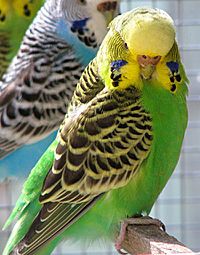Biological pigment facts for kids
A biological pigment is a pigment which gives an individual life form its colour.
Plants and animals have different reasons for being different colours, and their colours serve certain purposes. Chlorophyll in plants is a green pigment used to collect light energy to be used in photosynthesis. Many colours in plants and animals work to change the behaviour of animals. For example, some plants and animals use camouflage, warning or attraction (in order to help pollination or to find a partner.
The common dark pigment melanin often has the function of protection against sunlight and ultraviolet radiation.
Pigments are different from structural colours. Pigments look the same from all angles. Structural color is the result of reflection or iridescence. Structular colour means that certain creatures appear from different angles to have different colours. For example, the wings of a butterfly look different from some angles compared to others.
Images for kids
-
Space-filling model of the chlorophyll molecule.
-
Anthocyanin gives these pansies their purple pigmentation.
See also
 In Spanish: Pigmentos en seres vivos para niños
In Spanish: Pigmentos en seres vivos para niños




